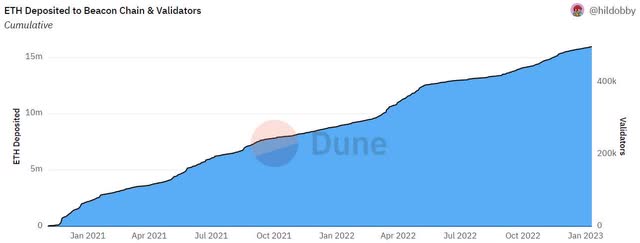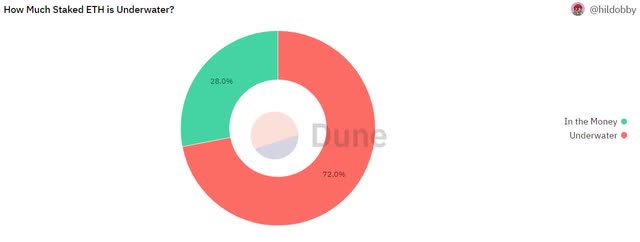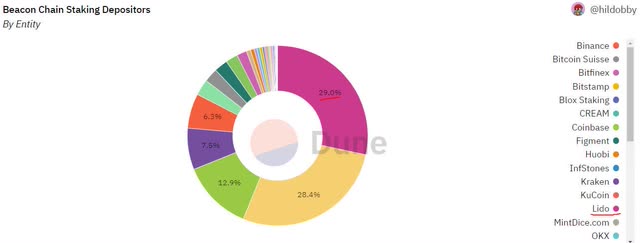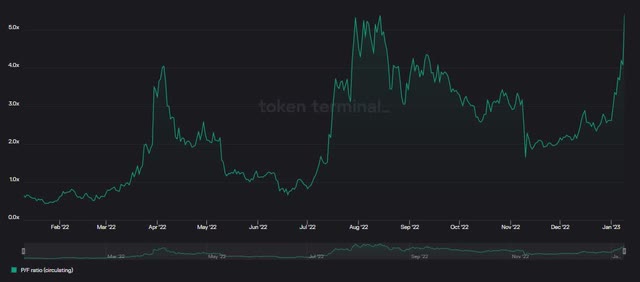
Liliya Filakhtova
It has been about four months since the successful transition from proof-of-work to proof-of-stake on the Ethereum (ETH-USD) blockchain. The much anticipated catalyst turned out to be a “sell the news” event with ETH declining roughly 15% shortly following the completion of the merge. That decline was short-lived however as Ethereum rallied from $1,220 in late-September up to $1,680 in early-November. Then FTX (FTT-USD) collapsed and the rest is history; the broad crypto slide resumed and we’re still learning of some of the contagion implications.
Despite the apparent off-chain issues at centralized companies like Gemini and Digital Currency Group, the on-chain assets appear to be forming a short term bottom with Ethereum having now rallied 25% from the post-FTX low of $1,080 in November. For Ethereum bulls and smart contract investors more broadly, the next big catalyst for the Ethereum blockchain may be the upcoming Shanghai upgrade. In this article, we’ll get into what Shanghai enables, and assess what it could mean for both Ethereum and one of the more popular protocols that is built on Ethereum; Lido Finance (LDO-USD).
What is Ethereum’s Shanghai upgrade?
The Shanghai upgrade on the Ethereum blockchain is the next upgrade in the chain’s technological development. According to the Ethereum community, the main change to Ethereum from Shanghai will be the ability for Ethereum stakers to withdraw funds from stake:
This network upgrade is estimated for the first half of 2023, subject to change until completed. After the Shanghai update, stakers will then be able to withdraw their rewards and/or principle [sic] deposit from their validator balance if they choose.
In a recent meeting, the Ethereum core developers put a March 2023 target for the Shanghai upgrade. Unlike most other proof-of-stake blockchains, which have allowed coin withdrawal from the beginning, stakers on Ethereum’s Beacon chain aren’t currently able to withdraw funds.

Staked ETH (Dune Analytics/hildobby)
The ability to take coins out of stake is significant and could potentially have an impact on the 15.9 million ETH that are currently staked on the blockchain.
ETH Supply Flood?
Enabling ETH withdrawal from stake following Shanghai does raise a key question; could unstaking put sell pressure on Ethereum as funds come out of lock? Possibly. But I think there might be a greater chance that the ability to unstake could actually bring more ETH into stake rather than out of stake. I take this view because I think there are potential staking participants on the sidelines who have been waiting to see how the merge and subsequent network upgrades go before locking funds without an ability to withdraw.
Despite Ethereum’s massive TVL, the network has a relatively small staking ratio compared to other smart contract blockchains:
| Blockchain | TVL in $ | Staking Ratio |
|---|---|---|
| Ethereum | $24.6b | 13.8% |
| Binance Smart Chain (BNB-USD) | $4.4b | 97.2% |
| Tron (TRX-USD) | $4.1b | 45.0% |
| Polygon (MATIC-USD) | $1.0b | 39.4% |
| Avalanche (AVAX-USD) | $797m | 62.5% |
Sources: DeFi Llama, StakingRewards.com
Even if ETH stakers wanted to immediately get their coins out following the implementation of the Shanghai upgrade, most won’t be able to right away as there will be a limited number of coins that can be withdrawn per epoch:
full validator exits are rate limited by the protocol, so only six validators may exit per epoch (every 6.4 minutes, so 1350 per day, or only ~43,200 ETH per day
This means that with just under 16 million ETH currently in stake, it would take a year of constant withdrawals to drain the ETH staked on chain for selling purposes. Furthermore, what will the motivation be to get ETH out of stake? Sell at a loss?

ETH Stakers (Dune Analytics/hildobby)
72% of the coins that have been staked on Ethereum are underwater. In my view, it’s more likely these market participants with staked ETH are closer to long haul Ethereum supporters rather than seekers of short term gains from any ETH merge narrative trade.
The Liquid Stake Trade
If the Shanghai upgrade does take place in March, I think it might paradoxically be a catalyst for more staking on Ethereum. In my view, enabling ETH stake withdrawals de-risks staking ETH on chain and could theoretically lead to an increase in ETH’s staking ratio rather than a decrease. If that is indeed the case, DeFi applications that enable liquid staking figure to enjoy increases in user adoption.
I’ve covered two of the more popular liquid staking protocols on Ethereum in the past; one for Seeking Alpha’s public site and the other as a ‘Top Token Idea’ for subscribers of BlockChain Reaction. Without re-writing my original Lido Finance article from last July, the two main problems that liquid staking applications on Ethereum solve are the staking threshold minimum and the locking of funds.
When a user stakes ETH through a liquid staking application like Lido, the user doesn’t need a minimum of 32 ETH to enjoy staking rewards and the platform mints an ETH derivative, in Lido’s case stETH, which can be used in various other DeFi applications for additional on-chain activities.

Staked ETH Share (Dune Analytics/hildobby)
This ability to stake ETH without the high minimum but also maintain liquidity has led to Lido Finance accounting for 29% of all of the ETH that has been staked. And Lido is just one liquid staking platform; liquid staking on Ethereum cumulatively makes up 43% of the Ethereum in stake. In my view, this gives credence to the idea that ETH withdrawals won’t lead to a supply flood – ETH stakers have already had liquidity options if they want them.
If anything, I take the view that enabling withdrawals will see more Ethereum coming into stake. In which case, the staking minimum of 32 ETH still applies and market participants will likely look to liquid staking products like those that are offered by Lido Finance or Coinbase (COIN):
| Name | Staked ETH | TVL | Market Share |
|---|---|---|---|
| Lido Finance | 4,859,909 | $6.52b | 74.66% |
| Coinbase | 1,025,945 | $1.36b | 15.76% |
| Rocket Pool | 352,168 | $472.51m | 5.41% |
| StakeWise | 82,525 | $110.73m | 1.27% |
| StakeHound | 65,379 | $87.72m | 1.00% |
Source: DeFi Llama
The top 3 liquid stake applications make up more than 95% of the liquid staked ETH and Lido is by far the top protocol in the category. Despite what I view as a strong fundamental setup for liquid staking on Ethereum as a general idea, I would caution getting overly exuberant with Lido Finance’s application governance token as a trade currently:

LDO Price to Fees (Circulating) (Token Terminal)
Lido’s LDO token has rallied over 100% in just two weeks and is currently trading at a 5.4x price to fees ratio, indicating it is overvalued based on the coin’s past trading history.
Risks
Ethereum’s Shanghai upgrade could once again be a sell the news event as the merge was before it. It’s also possible the upgrade actually does lead to a flow of ETH out of stake – the result of which would likely lead to lower ETH prices. For Lido Finance specifically, the protocol has a commanding share of not just liquid staking being done on Ethereum, but staking on Ethereum in general. It’s entirely possible Lido Finance loses staking share to other DeFi protocols or centralized business competitors like Coinbase.
Summary
The Shanghai upgrade is a fast approaching catalyst for Ethereum that will enable staked ETH withdrawals. While there is some thinking that this could lead to a large flow of ETH coming out of stake and creating a supply flood that crushes price, I think one could actually make the case that it will do the opposite and see more ETH going into stake. I take this view because the current ETH in stake is a low percentage of the total supply and is already very liquid with 43% of it having derivative tokens minted for further deployment in DeFi platforms or outright selling to new holders.
If Shanghai results in more ETH coming into stake, platforms like Lido Finance and Coinbase’s ETH staking product could benefit by serving token holders with smaller positions who don’t meet the minimum staking requirements of home validation on Ethereum. All that said, caution is likely warranted as the recent exuberance from LDO buyers has led to a rise in token price that has outpaced growth in demand for the product over the last few weeks as evidenced by the high price to fees ratio in the coin.
 Decode the digital asset space with BlockChain Reaction. Forget about the dog money. With over 20,000 coins, malinvestment was begging to be purged. But not every coin is disaster. In BCR I’ll help you find the ones that have staying power. Service features include:
Decode the digital asset space with BlockChain Reaction. Forget about the dog money. With over 20,000 coins, malinvestment was begging to be purged. But not every coin is disaster. In BCR I’ll help you find the ones that have staying power. Service features include:
- My Top Token Ideas
- Trade Alerts
- Portfolio Updates
- A Weekly Newsletter
- Full Podcast Archive
- Live Chat
Crypto Winter can be cold and brutal. But there is value in public blockchain and distributed ledger technology. Sign up today and position your portfolio for the future!


